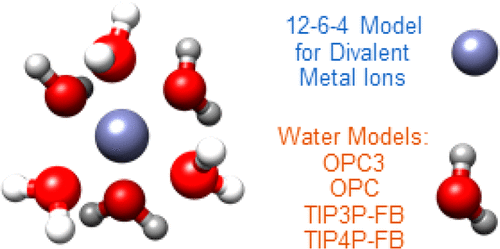当前位置:
X-MOL 学术
›
J. Chem. Theory Comput.
›
论文详情
Our official English website, www.x-mol.net, welcomes your
feedback! (Note: you will need to create a separate account there.)
Systematic Parametrization of Divalent Metal Ions for the OPC3, OPC, TIP3P-FB, and TIP4P-FB Water Models.
Journal of Chemical Theory and Computation ( IF 5.7 ) Pub Date : 2020-06-08 , DOI: 10.1021/acs.jctc.0c00194 Zhen Li 1 , Lin Frank Song 1 , Pengfei Li 2 , Kenneth M Merz 1, 3
Journal of Chemical Theory and Computation ( IF 5.7 ) Pub Date : 2020-06-08 , DOI: 10.1021/acs.jctc.0c00194 Zhen Li 1 , Lin Frank Song 1 , Pengfei Li 2 , Kenneth M Merz 1, 3
Affiliation

|
Divalent metal ions play important roles in biological and materials systems. Molecular dynamics simulation is an efficient tool to investigate these systems at the microscopic level. Recently, four new water models (OPC3, OPC, TIP3P-FB, and TIP4P-FB) have been developed and better represent the physical properties of water than previous models. Metal ion parameters are dependent on the water model employed, making it necessary to develop metal ion parameters for select new water models. In the present work, we performed parameter scanning for the 12-6 Lennard-Jones nonbonded model of divalent metal ions in conjunction with the four new water models as well as four previous water models (TIP3P, SPC/E, TIP4P, and TIP4P-Ew). We found that these new three-point and four-point water models provide comparable or significantly improved performance for the simulation of divalent metal ions when compared to previous water models in the same category. Among all eight water models, the OPC3 water model yields the best performance for the simulation of divalent metal ions in the aqueous phase when using the 12-6 model. On the basis of the scanning results, we independently parametrized the 12-6 model for 24 divalent metal ions with each of the four new water models. As noted previously, the 12-6 model still fails to simultaneously reproduce the experimental hydration free energy (HFE) and ion-oxygen distance (IOD) values even with these new water models. To solve this problem, we parametrized the 12-6-4 model for the 16 divalent metal ions for which we have both experimental HFE and IOD values for each of the four new water models. The final parameters are able to reproduce both the experimental HFE and IOD values accurately. To validate the transferability of our parameters, we carried out benchmark calculations to predict the energies and geometries of ion–water clusters as well as the ion diffusivity coefficient of Mg2+. By comparison to quantum chemical calculations and experimental data, these results show that our parameters are well designed and have excellent transferability. The metal ion parameters for the 12-6 and 12-6-4 models reported herein can be employed in simulations of various biological and materials systems when using the OPC3, OPC, TIP3P-FB, or TIP4P-FB water model.
中文翻译:

OPC3,OPC,TIP3P-FB和TIP4P-FB水模型的二价金属离子的系统参数化。
二价金属离子在生物和材料系统中起重要作用。分子动力学模拟是在微观层面研究这些系统的有效工具。最近,已经开发了四个新的水模型(OPC3,OPC,TIP3P-FB和TIP4P-FB),它们比以前的模型更好地代表了水的物理特性。金属离子参数取决于所采用的水模型,因此有必要为选择新的水模型开发金属离子参数。在目前的工作中,我们结合四个新的水模型以及四个先前的水模型(TIP3P,SPC / E,TIP4P和TIP4P-)对12-6 Lennard-Jones二价金属离子非键合模型进行了参数扫描Ew)。我们发现,与相同类别中的以前的水模型相比,这些新的三点和四点水模型在模拟二价金属离子方面提供了相当或显着提高的性能。在所有8种水模型中,使用12-6模型时,OPC3水模型在模拟水相中的二价金属离子方面表现出最佳性能。根据扫描结果,我们分别使用四个新水模型中的每个参数分别对12-6模型中的24种二价金属离子进行了参数设置。如前所述,即使使用这些新的水模型,12-6模型仍然无法同时重现实验的水合自由能(HFE)和离子氧距离(IOD)值。为了解决这个问题,我们为16种二价金属离子参数化了12-6-4模型,对于这四个新水模型,我们都有实验HFE和IOD值。最终参数能够准确再现实验HFE和IOD值。为了验证参数的可传递性,我们进行了基准计算,以预测离子-水团簇的能量和几何形状以及镁的离子扩散系数2+。通过与量子化学计算和实验数据的比较,这些结果表明我们的参数经过精心设计并且具有出色的可传递性。当使用OPC3,OPC,TIP3P-FB或TIP4P-FB水模型时,本文报道的12-6和12-6-4模型的金属离子参数可用于各种生物和材料系统的模拟中。
更新日期:2020-07-14
中文翻译:

OPC3,OPC,TIP3P-FB和TIP4P-FB水模型的二价金属离子的系统参数化。
二价金属离子在生物和材料系统中起重要作用。分子动力学模拟是在微观层面研究这些系统的有效工具。最近,已经开发了四个新的水模型(OPC3,OPC,TIP3P-FB和TIP4P-FB),它们比以前的模型更好地代表了水的物理特性。金属离子参数取决于所采用的水模型,因此有必要为选择新的水模型开发金属离子参数。在目前的工作中,我们结合四个新的水模型以及四个先前的水模型(TIP3P,SPC / E,TIP4P和TIP4P-)对12-6 Lennard-Jones二价金属离子非键合模型进行了参数扫描Ew)。我们发现,与相同类别中的以前的水模型相比,这些新的三点和四点水模型在模拟二价金属离子方面提供了相当或显着提高的性能。在所有8种水模型中,使用12-6模型时,OPC3水模型在模拟水相中的二价金属离子方面表现出最佳性能。根据扫描结果,我们分别使用四个新水模型中的每个参数分别对12-6模型中的24种二价金属离子进行了参数设置。如前所述,即使使用这些新的水模型,12-6模型仍然无法同时重现实验的水合自由能(HFE)和离子氧距离(IOD)值。为了解决这个问题,我们为16种二价金属离子参数化了12-6-4模型,对于这四个新水模型,我们都有实验HFE和IOD值。最终参数能够准确再现实验HFE和IOD值。为了验证参数的可传递性,我们进行了基准计算,以预测离子-水团簇的能量和几何形状以及镁的离子扩散系数2+。通过与量子化学计算和实验数据的比较,这些结果表明我们的参数经过精心设计并且具有出色的可传递性。当使用OPC3,OPC,TIP3P-FB或TIP4P-FB水模型时,本文报道的12-6和12-6-4模型的金属离子参数可用于各种生物和材料系统的模拟中。































 京公网安备 11010802027423号
京公网安备 11010802027423号